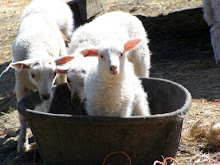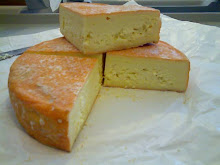Some age their cheese in caves, others in cellars. Caves are usually freestanding structures while cellars are below where the cheese is crafted. Several caves come to mind here in Vermont:
Vermont Shepherd (the first cave constructed to my knowledge), Lazy Lady Farm, Willow Hill Farm, Orb Weaver Farm and the newest, Jasper Hill Farm. Somehow we get confused in consumers' minds often with Jasper Hill Farm. I have attended the Burlington Farmers Market now for 16 years and every Saturday approximately 1200 people walk by my booth. I am asked each week at least once if we are from Jasper Hill or if we age our cheeses there. Perhaps it's the word 'hill' that creates the confusion? Of cheese farms in Vermont with the word 'hill' in it, we were the first. There are now several "hill" farms: Willow Hill, Cobb Hill, Thistle Hill, Jericho Hill, Jasper Hill. What is it with the word hill? Someone recently asked me if I knew Twig HILL Farm? I wanted to reply, "It's called Twig Farm, silly!"
We built our cave in 1999 with materials from our farm. The stones that created the retaining walls and the front facade all came from the hill that my husband, David, excavated himself. We built this cave to adjoin to the natural bedrock in the back of the rooms to provide extra humidity...like a mini-Roquefort cave. The seepage that occurs through it is entirely weather dependent, and hence a huge challenge from a cheese maker's point of view. It is not climate controlled so our 'terroir' is exactly that. Each year, analogous to wine, the cheeses ripen into a different 'vintage'. In 2005 for example, it was very wet, so the Blue Moons (our natural rind sheep milk blue) were quite moist with a thicker rind...........much like the texture of a sweet Gorgonzola as it held a lot of moisture in the paste (the interior of the cheese).

All of our mature cheeses are 'plank aged', meaning they are cured on boards-- that were also made here on the farm. We purchased a portable sawmill many years ago to harvest the wood for our house which is post and beam construction and it truly has been handy in building bridges (literally), cow barns, sheds etc. And cheese boards. The wood harvested for the planks is white ash which is a hardwood and very lightweight-helpful for maneuvering and washing. Cheeses are turned daily in the beginning of their affinage and less often as they age. As they give off moisture and develop a rind, the boards must be washed frequently and rotated into different locations through the cave as new cheeses enter each week to begin their aging process. This is a brief introduction to our cave...people often ask to visit our caves. Unfortunately due to food security/sanitation reasons, our caves are not open for visiting at this time. Next project? On to harvesting and milling boards for siding our new cheese house. Finally! Then there's firewood....








